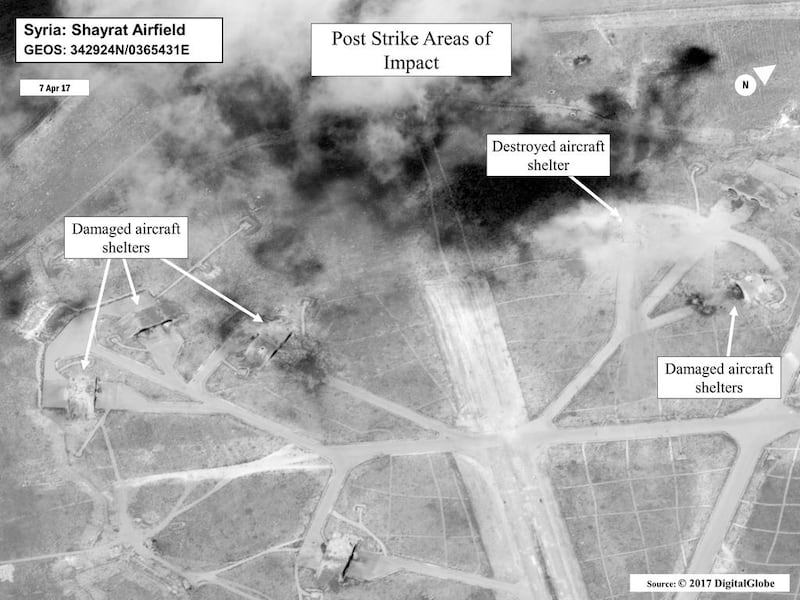BEIRUT // After 59 Tomahawk Land Attack Missiles slammed into Syria’s Shayrat airbase, the United States publicly patted itself on the back, confident that it had significantly disrupted the ability of the Syrian government to launch future chemical weapons attacks.
But by Friday evening, on the same day of the attack, the base – where Washington said last Tuesday’s chemical attack on the rebel-held town of Khan Sheikhoun was launched from – was already defiantly sending jets in the sky again to carry out fresh bombings.
On Monday Pentagon chief Jim Mattis said the US strike had destroyed a fifth of the Syrian government’s working warplanes, in addition to destroying petroleum and ammunition stores, air defence systems, hardened aircraft shelters and radars.
But it also left the runways of the base untouched, allowing surviving planes to continue launching missions.
To many observers, not targeting Shayrat’s runways – combined with the decision to inform Russia of the coming attack – seemed to underscore that the US strike was just a light-handed slap on the wrist, a one-off and poorly-executed show of American strength.
Amid rising criticism of Washington’s failure to take Sharyat offline, US secretary of state Rex Tillerson said the runways’ tarmac was too thick to sustain serious damage from Tomahawk cruise missiles. And on Saturday president Donald Trump took to Twitter to defend the decision, saying: “The reason you don’t generally hit runways is that they are easy and inexpensive to quickly fix (fill in and top)!”
Jeremy Binnie, the Middle East and Africa editor for Jane’s Defence Weekly, told The National that the decision not to hit the runways seemed appropriate given the limited impact of runway damage that cruise missiles can cause.
“A TLAM would put a large crater in an airstrip, but the damage would certainly be repairable,” he said. “Given this was a limited punitive strike, it probably made sense to use the missiles to inflict permanent damage to aircraft. In scenarios where you had too few missiles to hit all the aircraft and were engaged in a high-intensity conflict, it would probably make more sense to take the airbase temporarily out of service by cratering the runways.”
Cratered runways are something that can always be fixed, sometimes within a few hours by crews trained in runway repair. But such damage would disrupt use of an airbase and is the only thing that would ensure surviving planes are grounded – at least until the runways are returned to working condition.
But even if the US had wanted to crater the runways, Tomahawk missiles are not the ideal weapon for the job. The US has munitions that can take runways out of commission for longer time periods, such as the BLU-107, which was designed with the specific intent of destroying runways and creates craters that are much deeper and wider than those a Tomahawk can cause.
The BLU-107 – as well as other munitions that would have been more useful in penetrating the bunker-like hangars that jets at the Shayrat airbase were housed in – is a weapon that needs to be delivered by fixed-wing aircraft that are flown by pilots.
But with Russian and Syrian air defences active in the area, ordering US planes to strike the airbase could have put the lives of pilots at risk and led to an even more dangerous escalation if they were attacked.
Tomahawk missiles, however, are launched from ships at sea; those used in Friday’s strike on the Shayrat base near the western city of Homs were launched from two US navy destroyers in the eastern Mediterranean.
Causing damage that takes runways out of commission for an extended time period requires a level of commitment and risk that the US is unwilling to take right now. Short of dropping more suitable ammunition from jets, the US would have to resort to using repeated waves of cruise missiles to continue damaging the runway after it was fixed, or strike against runway repair crews and their equipment.
Both of those options would prolong the escalation and further raise tensions with Damascus and Moscow.
Still, some in the US, like former fighter pilot and US senator John McCain, feel that more should have been done to keep the planes at Shayrat grounded.
“The signal that they’re able to fly again almost right away out of the same facility indicates that I don’t think we did as thorough enough job, which would have been cratering the runways,” he said in an interview with CBS’ Face the Nation on Sunday.
“And somebody will say ‘well, then they can fill in the runways’. Yeah, and we can crater them again too.”
jwood@thenational.ae
* With additional reporting from Agence France-Presse





